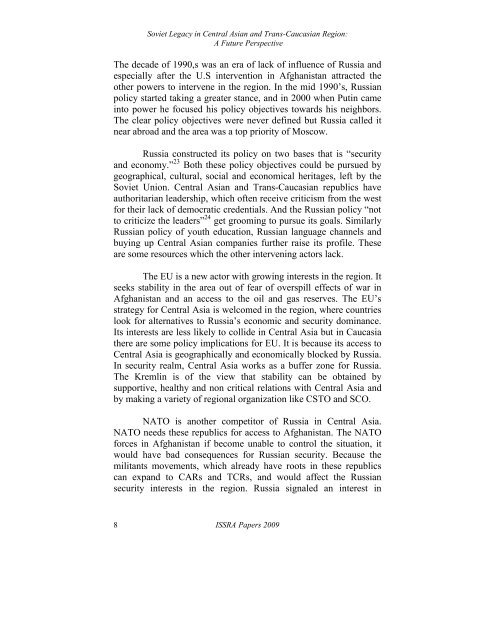issra papers vol i, 2009 - National Defence University
issra papers vol i, 2009 - National Defence University
issra papers vol i, 2009 - National Defence University
You also want an ePaper? Increase the reach of your titles
YUMPU automatically turns print PDFs into web optimized ePapers that Google loves.
Soviet Legacy in Central Asian and Trans-Caucasian Region:<br />
A Future Perspective<br />
The decade of 1990,s was an era of lack of influence of Russia and<br />
especially after the U.S intervention in Afghanistan attracted the<br />
other powers to intervene in the region. In the mid 1990’s, Russian<br />
policy started taking a greater stance, and in 2000 when Putin came<br />
into power he focused his policy objectives towards his neighbors.<br />
The clear policy objectives were never defined but Russia called it<br />
near abroad and the area was a top priority of Moscow.<br />
Russia constructed its policy on two bases that is “security<br />
and economy.” 23 Both these policy objectives could be pursued by<br />
geographical, cultural, social and economical heritages, left by the<br />
Soviet Union. Central Asian and Trans-Caucasian republics have<br />
authoritarian leadership, which often receive criticism from the west<br />
for their lack of democratic credentials. And the Russian policy “not<br />
to criticize the leaders” 24 get grooming to pursue its goals. Similarly<br />
Russian policy of youth education, Russian language channels and<br />
buying up Central Asian companies further raise its profile. These<br />
are some resources which the other intervening actors lack.<br />
The EU is a new actor with growing interests in the region. It<br />
seeks stability in the area out of fear of overspill effects of war in<br />
Afghanistan and an access to the oil and gas reserves. The EU’s<br />
strategy for Central Asia is welcomed in the region, where countries<br />
look for alternatives to Russia’s economic and security dominance.<br />
Its interests are less likely to collide in Central Asia but in Caucasia<br />
there are some policy implications for EU. It is because its access to<br />
Central Asia is geographically and economically blocked by Russia.<br />
In security realm, Central Asia works as a buffer zone for Russia.<br />
The Kremlin is of the view that stability can be obtained by<br />
supportive, healthy and non critical relations with Central Asia and<br />
by making a variety of regional organization like CSTO and SCO.<br />
NATO is another competitor of Russia in Central Asia.<br />
NATO needs these republics for access to Afghanistan. The NATO<br />
forces in Afghanistan if become unable to control the situation, it<br />
would have bad consequences for Russian security. Because the<br />
militants movements, which already have roots in these republics<br />
can expand to CARs and TCRs, and would affect the Russian<br />
security interests in the region. Russia signaled an interest in<br />
8<br />
ISSRA Papers <strong>2009</strong>

















